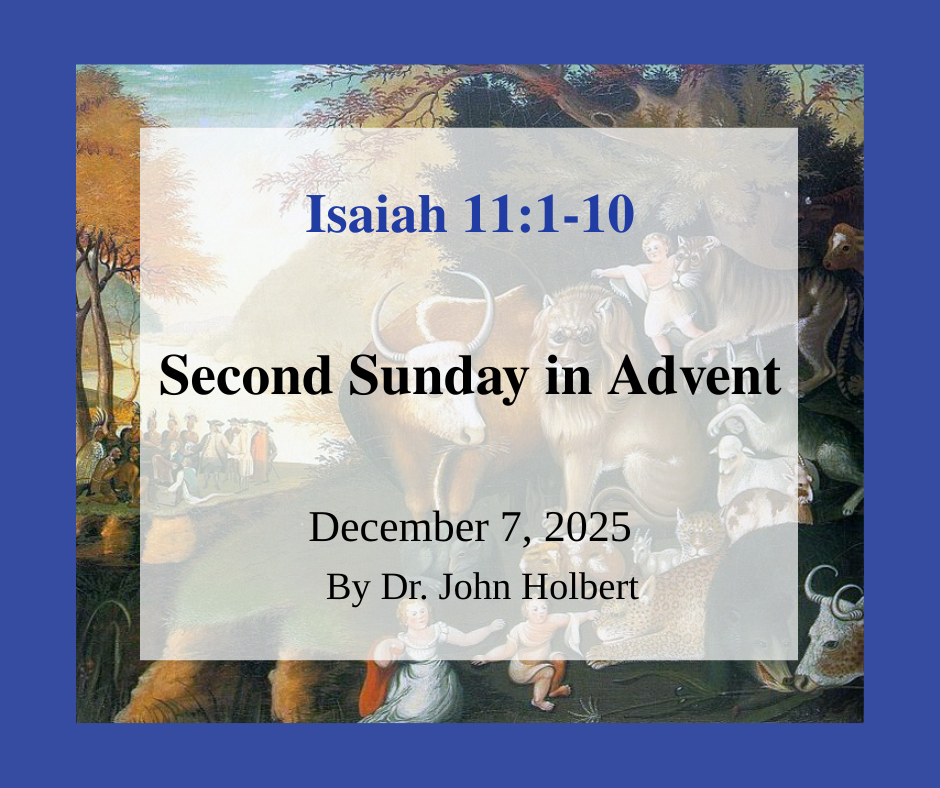Reflections on Isaiah 11:1-10, Second Sunday in Advent, Year A
by John C. Holbert on Friday, October 10, 2025

The second Sunday of Advent regularly gives us this magnificent passage from Isaiah, a text that has served artists, poets, and composers for centuries as the basis for grand paintings, mellifluous poems, and stirring anthems, seen and heard by millions. Its images of the “peaceable kingdom,” where lions and oxen eat straw together (do not try this in the real world!), where a nursing child plays idly over the hole of a deadly snake (mothers and fathers, beware!), where there will be no more strife on the holy mountain of God (Armageddon, be gone!). It is without doubt the single most hopeful and glorious portrayal in our Hebrew Bible, and has served us as a “signal to the peoples,” a living witness to the “glorious dwelling of God” (Is.11:10).
However, exactly what is the generative event or events that triggered this fabulous portrait in the poetry of the prophet Isaiah? We all know what the early Christians found here: the child is Jesus, the coming gift of God, and with his coming this peaceable world will ensue. Why else include the text in the promising season of Advent? But, of course, when Jesus came into the world of Roman power, and was murdered by that same power, nothing at all seemed to change. The Romans continued to run the world for several centuries until one of its emperors, Constantine, in the fourth century CE, made Christianity the official religion of the empire with the result that wolves did not lie down with lambs, nor did lions and oxen eat straw together, nor did any child stick its hand safely into a snake’s den. Wolves ate lambs; lions devoured oxen; poisonous snakes needed to still to be avoided.
It appears certain that for 8th century BCE Isaiah what occasioned his hope for the world was the reign of the great king David. Who else, after all, is the “root from the stump of Jesse” (Is.11:1), the 8th son of an unknown farmer of Bethlehem, strangely anointed by the aging prophet Samuel, in the presence of his incredulous brothers? This David ruled Judah for 7 years, and a united Israel for 33 more, before dying alone and cold in his Jerusalem bedroom, having established the son of Bathsheba, Solomon, on the throne of Israel, to the horror and disgust of his eldest child and a host of other sons too numerous to count. Far from being a sweet child, playing idly with serpents, this David was himself something of a poisonous serpent, murdering and lying his way to power, even dispatching an old and helpless enemy on his deathbed. In what way exactly was this David the sign of any glorious dwelling, any wielder of righteousness and justice, any exemplar of faithfulness (Is.11:5)?
Exactly when this famous oracle was written is the subject of much scholarly dispute. Was it in fact part of 8th century Isaiah’s work, the result of a hope for a new David-like ruler who would, unlike the historical king, finally bring in a reign of justice and peace? Or was it a much later composition, written by a disciple of the great Isaiah, who looked longingly through the rubble of a devastated Jerusalem, and dreamed of a ruler unlike in every way that complicated David of history, a king who would represent the goals and hopes of YHWH for peace and justice in some distant time and place?
However we answer that question, and no simple answer will ever be discovered, the reality is that in this and every Advent we all long desperately for such a leader, one characterized by righteousness, one who treats each one as worthy of access to all goods and services of society, and does not exclude anyone due to skin color or lack of prestige or social class. This one will “judge the poor with righteousness and decide equally for the meek of the earth” (Is.11:4), and will set firm sight against those deemed “wicked” (Is.11:4b). All war will cease, because this one will focus like a laser on equality, openness, inclusion, fair play. Unlike the current world where leaders divide to conquer, snatch people of color off the streets, throw them into detention facilities, act through hatred of those deemed unworthy, treat the poor with disdain, aiding only the rich with larger tax cuts and further freedoms to grow their wealth without restraint. These actions are more like the historical David than this new hoped-for David.
Advent is ever a time for hope, a hope that flies in the face of the world in which we live. We all long every Advent for this wonderful child, filled with “a spirit of wisdom and understanding, counsel and power, a spirit of the knowledge of and worship of YHWH” (Is.11:2). No human being can encompass all this, hence the Christian hope of a new David, an anointed one who might move us toward genuine peace and unity. Early Christians pointed toward Jesus as the child long-expected, the one who might lead us in these wonderful ways. “Wise ones still seek him,” as the old saying goes, and so we do. But make no mistake: his coming must be our catalyst toward a completely different mode of living. We must not rely only on this one to solve our problems for us. Advent is about us as much as it is about the long-hoped-for one.
